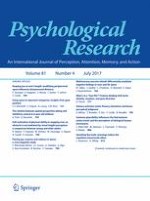15-06-2016 | Original Article
Using space to represent categories: insights from gaze position
Gepubliceerd in: Psychological Research | Uitgave 4/2017
Log in om toegang te krijgenAbstract
We investigated the boundaries among imagery, memory, and perception by measuring gaze during retrieved versus imagined visual information. Eye fixations during recall were bound to the location at which a specific stimulus was encoded. However, eye position information generalized to novel objects of the same category that had not been seen before. For example, encoding an image of a dog in a specific location enhanced the likelihood of looking at the same location during subsequent mental imagery of other mammals. The results suggest that eye movements can also be launched by abstract representations of categories and not exclusively by a single episode or a specific visual exemplar.
